

 The Accurate Reloading Forums
The Accurate Reloading Forums  THE ACCURATE RELOADING.COM FORUMS
THE ACCURATE RELOADING.COM FORUMS  Guns, Politics, Gunsmithing & Reloading
Guns, Politics, Gunsmithing & Reloading  Reloading
Reloading  Headspace / Resizing problems: 300 WSM (updated since 1/2010)
Headspace / Resizing problems: 300 WSM (updated since 1/2010)Go  | New  | Find  | Notify  | Tools  | Reply  |  |
| one of us |
Cal: 300 WSM Brass: Norma I have been experimenting with the Sinclair “Bump Gage Insert” in an effort to determine the optimum shoulder bump to use with my Redding Body Only die. I measured two groups of brass. One that had only been fireformed (fired once) and the other that had been fired about three times. Both groups each had their own distribution; the once-fired on the left side measuring between 1.7415” to 1.743” and the other group was a bit longer and measured between 1.7435” to 1.7465”. 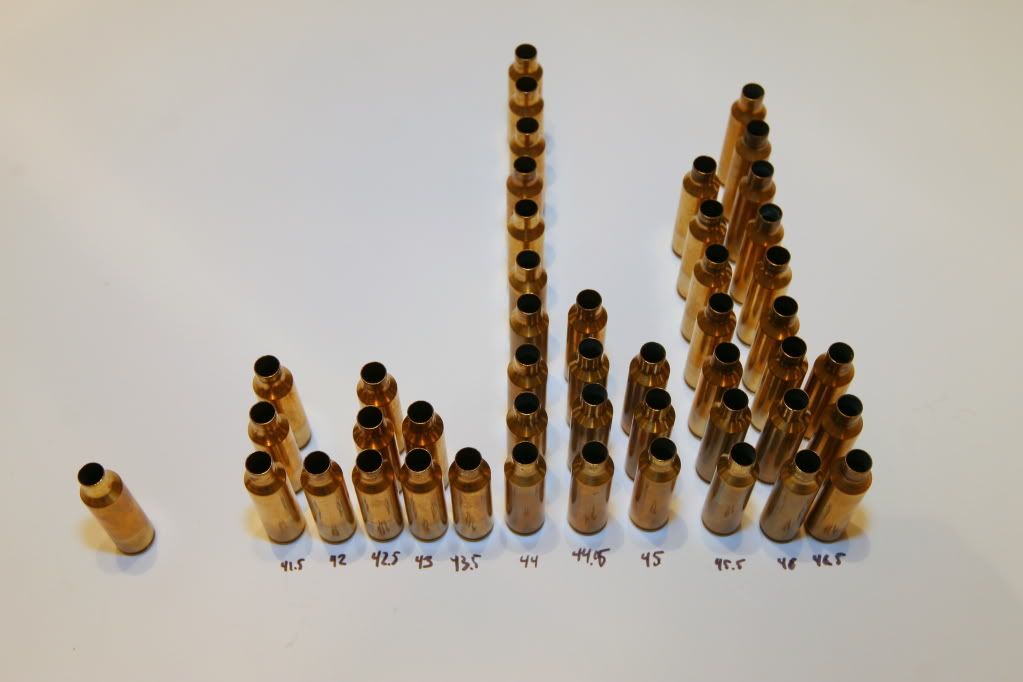 Subjectively, the brass that “felt” the best with a very slight crush fit was the 1.744” group. I was very pleased to learn this because this corresponded well to the 0.002” to 0.003” most people recommended based upon a poll I did a while back (here) asking opinions on which would be the ideal shoulder setback. So the simple plan was to bump the longer cases back to 1.744” along with the others. Herein lies the problem… It seems that when I sized a 1.7465” case down in the Body Only die to 1.744” there was still a very tight fit and it took more pressure than I was comfortable with to close the bolt. In fact, it would smear the stamped letters on the head of the case. I continued to turn the die down in infinitesimal increments until I achieved a fit that was similar to the feel of the 1.744” brass. Much to my surprise, this case measured 1.730” using the Bump Gage Insert. I repeated this process on the two remaining 1.7465” cases to be certain and I got the same results – 1.730”. It seems as if the Bump Gage is measuring at a point other than the datum line of the shoulder. I smoked a case using a wooden match and found that the Bump Gage is taking measurements from the junction of the neck and shoulder. 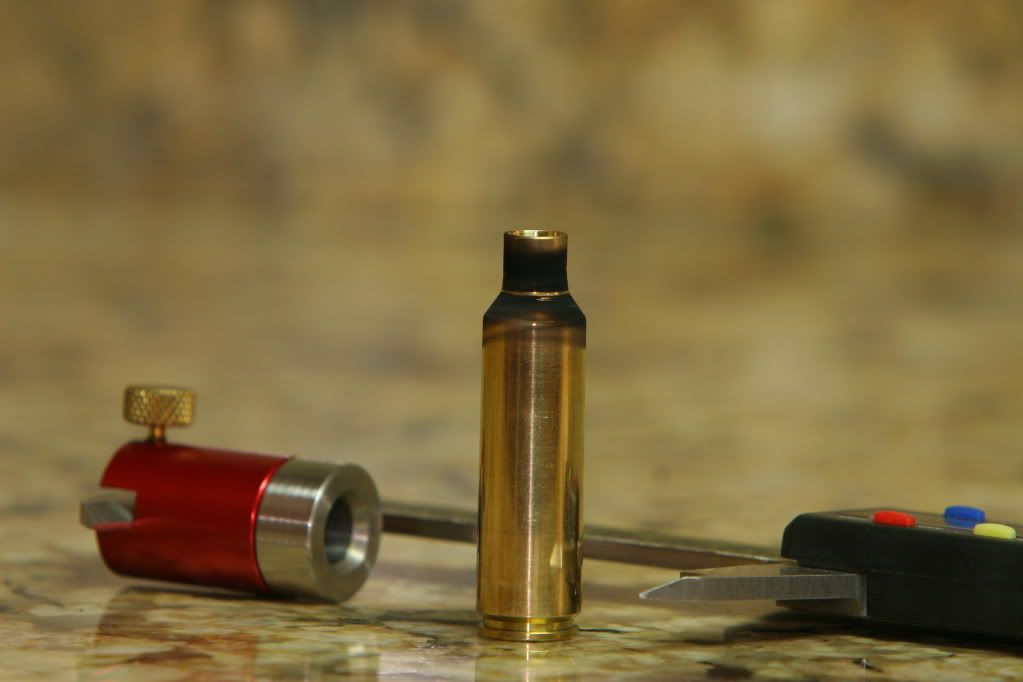 I am not completely clear as to why there is a discrepancy in feel from the original fired (non-sized) 1.744” cases and the cases in which I “bumped” to 1.744”. I assume it is because of where the gage is taking its measurements, but we all know where assumptions lead to… Any thoughts or suggestions? | ||
|
| one of us |
First, let me say that I have always found Sinclair Int'l.'s customer and technical support to be top notch. I was afraid some of that may have changed after the merge/acquisition of Brownell's but that has not been the case, thankfully. Below are two replies that I received from their Technical Support staff regarding the above issue. ====================================================== Email #1 After reading your case measurements on the 3x fired brass, I would measure the base of the cases and compare to the new unfired cases and the once fired cases. The fact you are setting the shoulder back so far leads me to think you have max loaded case. I think you will find the base of the 3x fired will be .001 -.0015 over the new cases. Check the once fired cases the same way. When I work up a load, I measure the base of the case from new and work from starting loads to max and measure the base until I swell the base .0005-.001 and subtract 1 grain of powder from the load that swelled the head of the case. Consider that load to be max. I do most of my load development at 85-95 DEG air temp. These loads usually work good in cold weather as well. The bump gauge measures from the shoulder and these are tapered and ideally it will hit the shoulder equally, but chamber reamer may be 1 DEG or so of speck or the barrel may have machined off center. This is not blaming the reamer or the gunsmith; I am trying to say that no 2 barrels will machine the same. They will be very close but you will find differences in 2 barrels cut with same reamer and at the same time. If the powder charges are safe and bullet seating is correct it may take 2 firings to fire form cases. The fact that you have set shoulder back that far leads me to think there is a pressure problem. If you take the shoulder back that far to chamber I will suggest you check the case down the sides and at the base. You may need a small base die to bring the side of the cases back to spec but you shouldn’t have to use it all the time. Thank you for your questions and feel free to call if more explanation is needed ======================================================= Email #2 I have some additional information from the folks in our mfg. area that will be in addition to the information that XXX forwarded to you in his e-mail reply for you. It is the following information: "The smoke is what proves that it is the same issue and it was smart of him to do that. It seems that after a few firings some of this brass is developing a doughnut at the neck shoulder junction and rather than staying crisp in that area, they a rounding out (think Weatherby shoulder only on the inside of that angle)." We will be sending you another insert and the shop wants to look it over first to make sure that it will be at the proper specifications for the application. | |||
|
| one of us |
Kenati, I can tell you the WSM can be tricky. I learned (with a lot of help here at AR) that when you are right on the edge of sizing 'just enough to bump the shoulder back'--by almost any method, you can miss the body sizng that affects fit too. It looks to me like the sizing gage is hitting on the junction of the shoulder as you described, and isn't giving you a measure of the shoulder at all--but perhaps that junction moves in concert with the datum point on the shoulder, but I would want the 'ring in the smoke' to be in the near middle of the shoulder. Several folks here admonished me to just go by feel and then measure between fired and sized cases that felt right, and that really worked well--with the formerly Stoney Point gage, now Hornady gage, it turned out to be right at .002 to .003, like you were striving for....I use the Forster bushing bump dies a lot, and on some of my 300 WSM's that's enough, on 2 I have to use a FLS die. I get great precision with the full lenght die, I just love the busing bump dies, cause I don't have to lube the cases--lazy huh??? Oh, BTW, I don't think your issue is related to doughnuts--will a bullet drop through the neck on a fired case??? Easy enough to determine that one. Anyways, interesting post, keep us updated as to your results. | |||
|
| One of Us |
Making those case measurements off the specific SAAMI datum diameter line is irrelivant, what IS relivant is that they all be measured off the same diameter. BUT, attempting to read off the neck:shoulder junction seems a bad idea because it would make the reference diameter somewhat iffy. I would either get a new, larger hole, cartridge bushing or ream/drill that one until it makes case contact much further up the shoulder. I've never been able to get any better consistacy than a 2 thou spread, fired or sized. Figger it's due to amall variations in the case alloy and/or work hardening. | |||
|
| one of us |
With all the High Tech equipment available to the Sinclair folks, it is indeed interesting to see them recommend the time-proven, never-fail, always-reliable, relatively-inexpensive CHE as their go-to Method for checking Pressure. Amazing!!! | |||
|
| one of us |
I haven't had a chance to measure the case heads yet, but will soon. I must admit, by buying the bump gage I may now be trying to finding a solution to a problem that might not even exist. Without the gage I simply would have adjusted my dies by feeding the brass through the rifle until they subjectively felt right. I tried to introduce some objectivity to the method by using the gage, but know I think the biggest question is: What am I really measuring? Hmmmmm... | |||
|
| one of us |
True to their word, Sinclair sent me a new bump gage at no cost. There was a note indicating that it had been carefully inspected for tolerances before being shipped out. I measured two FIRED and RE-SIZED cases and one NEW case using the replacement bump gage. As you can see below, the gage makes full contact with the datum line portion of the new case. The fired cases are, as before, being measured at the case neck and shoulder junction. One of the two fired cases did show a light ring at the datum line (middle case). 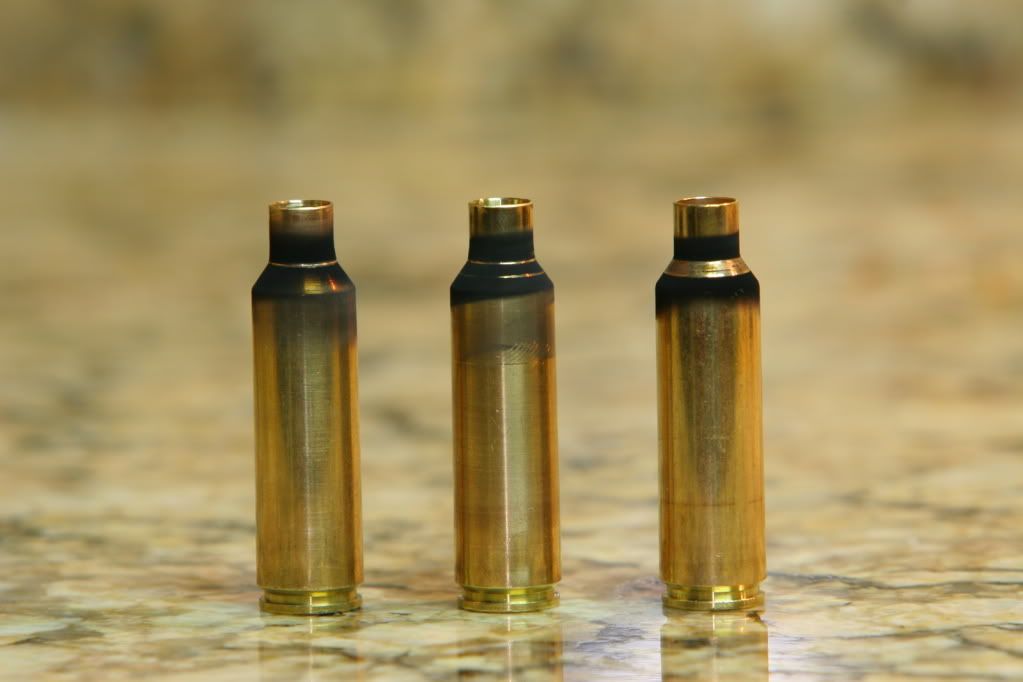 Perhaps my chamber is cut to different specifications. If so, I question the utility of continuing to use the bump gage because I do not think it is measuring the true dimensions that I am trying to use for die setup. Which brings me to another question, I wonder how the dimensions of the Redding body die compare to the rifle’s chamber dimensions? ====================================================================================================== Case Head Measurements As suggested above, I measured case heads of five NEW/UN-SIZED cases and five FIRED (2-3 firings)/RE-SIZED cases with the following results: New Cases 0.5530” Fired Cases: 0.5543” 0.5545” 0.5546” 0.5544” 0.5546” As you can see, this follows the prediction of the tech at Sinclair who wrote, “I think you will find the base of the 3x fired will be .001 -.0015 over the new cases.” So what do you guys think? Should I ignore this whole case bump gage contraption and continue to bump back the shoulder by feel? Or should I continue to use the gage and just back off the powder charge to see what that does? Admittedly, I am at the upper limits, but the 0.0015" CHE is the only symptom that I'm showing. Your thoughts are greatly appreciated. | |||
|
| one of us |
Kenati, what does your case head measure AFTER sizing? I'll let someone more knowledgeable than me chime in, but I personally would be curious as to how much the case is being 'worked' in the head area between sizing and firing.... As far as setting the shoulder back, if you are getting a consistent measurement and you are getting the fit in your chamber you want, then go with it. I think you have to feel like the feel (can you say that/) is right, I wouldn't like an occassional case to feel way to much of a crush fit if you have that much variance as an example.... Let us know how it goes. | |||
|
| one of us |
Thanks for the reply, Fish30114. First let me answer your original question. Yes, a bullet will drop through a case mouth without any trouble, so I too don't think there is a "doughnut ring" problem. And since I am only partially neck sizing using a Wilson inline hand die, the profile most likely looks something like this: 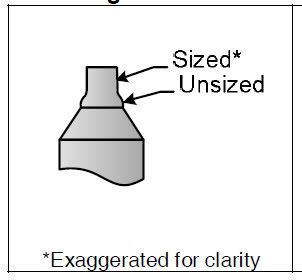 To answer your second question about CHE... The numbers above were taken from new unfired/unsized case and the fired cases were sized with the Redding body die. There is so much information here, I guess the point of this thread has been lost. Here's the bottom line: Using a bump gage insert as a measuring tool, I found that I had to bump my shoulder back 11 to 16 thousands of an inch in order to get an acceptable fit. That seemed like a hell of a lot to me so I questioned my method of measuring. Unfortunately, I still don't have a clear answer. | |||
|
| one of us |
This is sad, but over a year and a half later I am still looking for answers to this dilemma. I have reached a point where many of my cases are very tight chambering and this cannot be corrected with the Redding body die anymore. I am making very firm contact between the shellholder and the bottom of the Redding body die. Although there is some improvement in chambering resistance after sizing, many of the cases have bright marks on the heads from the extractor groove marring them during the cam action of closing the bolt. I smoked another case for illustration and sized it in both the body die and the Wilson neck hand die. The body die resulted in the rings labeled "A, B, C." The neck die produced the ring labeled "1". Interestingly, when I chambered the case, there were two concentric rings very close to one another that were situated exactly between the rings labeled B & C. This is evidence enough to me that the culprit is the distance from the bolt face to the datum line on the shoulder, as it should be. There was early speculation that my problem may be due to either a doughnut or case head expansion. I think either of the latter two possibilities are much less likely now. What are your thoughts? Solutions? It seems like it's going to require sending the die back to have material removed off of the bottom or have material removed off of the shellholder. Either way, something's got to give! 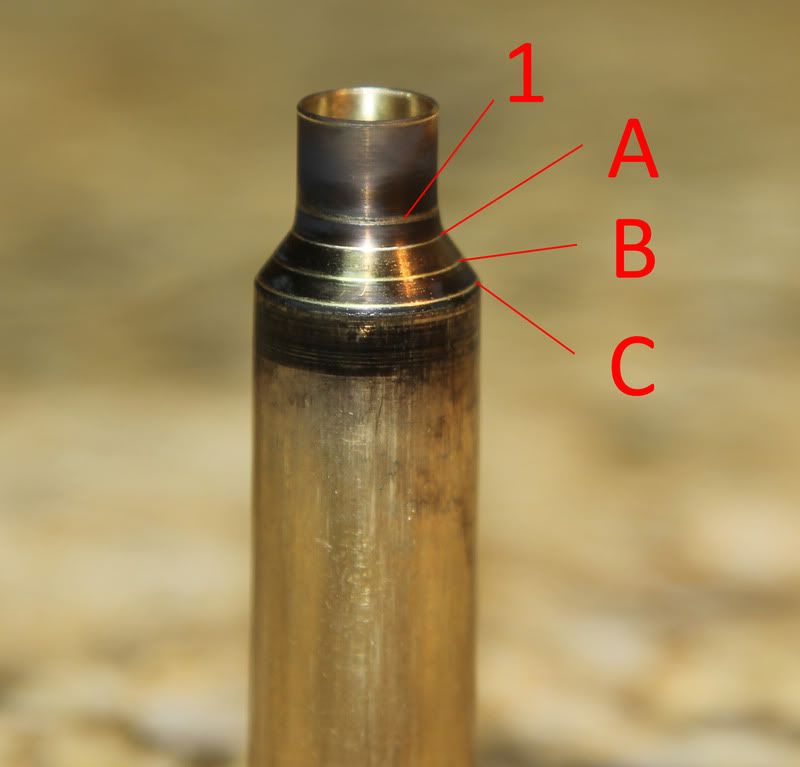 The case has the vertical scratch marks extending the entire length of the case, indicating that the base is being resized as well. 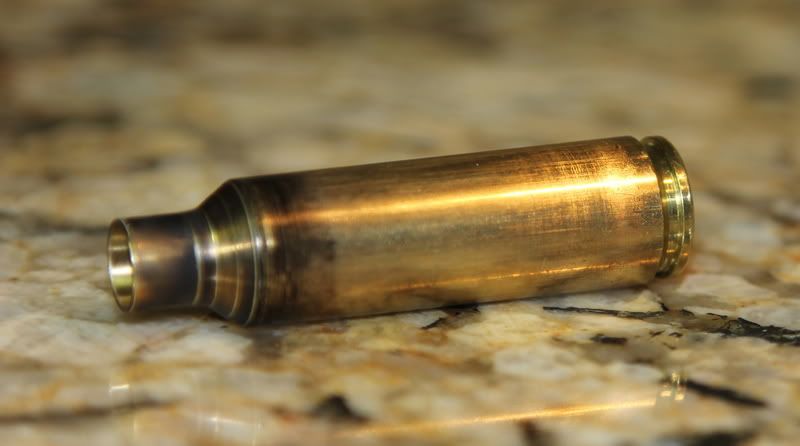 | |||
|
| one of us |
1.730" is what it should measure. The area between 1 & A in not getting sized. This is what is giving you a crush fit. Normal IMO. You should buy factory ammo, send 3 fired brass to RCBS and have custom dies made. Forget the gauge. SAAMI Drawings with Measurements of the 300 WSM > http://www.saami.org/PubResour...20Short%20Magnum.pdf | |||
|
| one of us |
Like i said, Get rid of the gage.
| |||
|
| One of Us |
Email #1 and Hot Core have the answer to your problem and question. I have encountered the same issue with my lot of .264 Winchester Magnum brass. I just finished prepping all of my brass for loading after finalizing the load development. I annealed all of the brass to return the neck and shoulders to "like new" condition. I used the headspace gauge and bumped the shoulders back .002" on all of the cases. A couple of my loaded rounds would not chamber or chambered with effort. I didn't shoot them and measured the amount of shoulder bump. It was perfect at .002". I ran all of my unloaded brass through the chamber to weed out the bad ones. I had about 7 cases out of 150 that had the issue. All of the cases had been sized correctly with .002" shoulder bump. I'm betting the bases of the cases are swollen from shooting some higher than normal pressure loads during development. I decapped the primers and one had a very noticably loose pocket. | |||
|
| one of us |
I agree with you that the area between 1 & A is not getting sized. However, I do not think it is contributing to the crush fit. I smoked several cases and chambered them. The area between 1 & A has not been disturbed at all. The area between B & C is the only thing making contact other than the case head. | |||
|
| one of us |
I am at the upper limits of my charge weight, so there very well could be pressure issues. Excessive? If I am to go by the case head expansion, I would say I am at or near max. I have not experienced any loose primer pockets and I arguably have the best available feel using the Sinclair hand priming tool. What did you do with the cases that would not fit? Where you able to resize them to usable pieces again? I should probably reemphasize this: All of my brass is currently a "crush fit" even though I setup my shellholder to very firmly make contact with the bottom of the die. I simply cannot size the brass any more than this. In 17 years of reloading, this is a first for me. | |||
|
| One of Us |
After I culled the ones that didn't chamber, I tried to size them a little more thinking that was the problem. It wasn't. I'm sure it was the base of the case as the email says. I don't have a micrometer to measure case head expansion. I've saved the cases to take to my gunsmith for his opinion, but I'm sure I'm just gonna chuck them. | |||
|
| One of Us |
An excellent example of "thingy" induced confusion. Aim for the exit hole | |||
|
| One of Us |
It sounds like the shoulder is being pushed forward when you size your cases. You can sometimes help this by sizing very slowly giving the brass time to flow. Then pull partially back out of the die. Spin the case 180 degrees and size slowly again. Lack of rigidity in the press and variations in the amount of lube used can affect the sizing. Double sizing can help make the position of the shoulder more consistent AND shorter. | |||
|
| One of Us |
Interesting thread. I bought a similar tool from Hornady because of the same problem I have been living with for 15 years. My Hornady gauge measures on the datum line - the reading is less than the SAMI spec from base to bottom of neck. A few random thoughts Just a few thought & I hope they at least help eliminate some possibilites and narrow down the issues. "When the wind stops....start rowing. When the wind starts, get the sail up quick." | |||
|
| One of Us |
I was thinking along these lines... Case neck diameter or length. I had a customer with a 270 Win in a Rem 700 recently who was having trouble feeding factory rounds. Headspace measured fine, but it turned out the neck dimensions were a little tight. I poked a reamer in the chamber and cleaned it out a little. That solved the problem. Is this a factory chamber that you have? Have you had a chamber cast done? You might look to having that done and then you will have some exact neck dimensions to load for. Curtis | |||
|
| one of us |
Thank you for your thoughts and reply. I appreciate the suggestions. My answers are below.
| |||
|
| One of Us |
What do you mean contact at the case head? 1. Are you talking about the face of the case head? 2. Contact near the case head at the the body diameter - AKA pressure ring? From what you are describing the reloading die is a few thousandths long internally. Try this. Remove the decapping stem. Use your standard die setting. Slide a .003 feeler gauge under the case head and size it. Check in your chamber. Still too tight? Use a .005 or .006 feeler and size. If the feeler gauges do not work you can do one of the following: 1. Grind off the top of the shell holder until the problem is corrected. Never use that shell holder with another cartridge/rifle combination. 2. Grind the sizing die. 3. Call Redding. See if they will take one of your fired cases and look at it on a comparator and "adjust" your sizer. | |||
|
| One of Us |
Kenati, Are you getting a shiny ring around the primer pocket from the bolt face rotation? What type of press are you using? You may have posted that but I am too tired to go back and reread it all. I have found on both of my WSMs that I HAVE to full length resize AND cam the handle/linkage over on my RCBS Jr. press. Simply running up to the die bottom won't do it. I have tried it on a Lee turret press and no luck. Not enough leverage. On my WSM cases the case face becomes convexed and needs to be pushed back in. You might have the same issue. If that don't do it then grind off the shell holder like SR said. Or better yet buy the Redding custom shell holders with the various lip thicknesses. "The right to bear arms" insures your right to freedom, free speech, religion, your choice of doctors, etc. ....etc. ....etc.... -----------------------------------one trillion seconds = 31,709 years------------------- | |||
|
| one of us |
Thanks for taking the time to respond. I know there is a lot to read through on this post. See my responses below for clarification.
| |||
|
| one of us |
| |||
|
| One of Us |
I am glad you sent your stuff to Redding. It would be even better if you could see what they will see. Using a large optical comparator they will be able to look at very enlarged shadows of your cases and will be able to measure them to within a few ten thousandths. They will also be able to tell if there is anything strange about your chamber. Your little press is not really beefy enough for FL sizing. I have one like it and use it only for bullet seating and neck sizing. Get a full size press with a compound linkage and a CLOSED frame. You will get much better results. | |||
|
| One of Us |
Kenati, I think the case face thickness was not increased over standard cases when designed, which it should have been since the case diameter was increased. The concept of the WSM case design is to have an increased amount of powder ignited at the same time which, I suppose, should mean a quicker pressure spike in most circumstances. That should result in alot of pressure on the brass case with a thin face. I do know that camming the press linkage over works with my RCBS press and won't work with neither my Lee turret press nor hand press since neither of those will do that. My RCBS press will actually spring the top die area upward due to the leverage of the linkage design. My Lee setup won't even come close. Just my thoughts and observations. "The right to bear arms" insures your right to freedom, free speech, religion, your choice of doctors, etc. ....etc. ....etc.... -----------------------------------one trillion seconds = 31,709 years------------------- | |||
|
| one of us |
I've got a Rock Chucker Supreme too. I tried both... same issue. No difference. | |||
|
| One of Us |
Same issue in this case (to make a bad pun). But this case is most likely a bad die. Even when you get the die fixed I think you will find a Rock Chucker more reliable for large diameter cases. | |||
|
| Powered by Social Strata |
| Please Wait. Your request is being processed... |
|
 The Accurate Reloading Forums
The Accurate Reloading Forums  THE ACCURATE RELOADING.COM FORUMS
THE ACCURATE RELOADING.COM FORUMS  Guns, Politics, Gunsmithing & Reloading
Guns, Politics, Gunsmithing & Reloading  Reloading
Reloading  Headspace / Resizing problems: 300 WSM (updated since 1/2010)
Headspace / Resizing problems: 300 WSM (updated since 1/2010)

Visit our on-line store for AR Memorabilia

